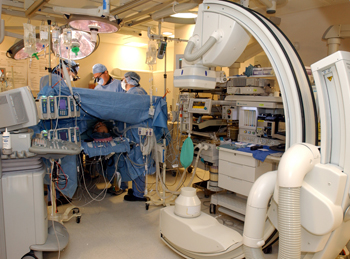
Vanderbilt’s hybrid operating room brings together the equipment needed to perform both open-heart surgeries and percutaneous coronary interventions and procedures. photo by Dana Johnson
Study shows bypass imaging helps reduce graft defects
The technique for coronary artery bypass graft (CABG) surgery has largely remained the same over the last 35 years, including closing the chest without really knowing whether the bypass grafts are potentially kinked, constricted or otherwise impaired.
Because technical defects are thought to be largely responsible for graft failure, Vanderbilt Heart & Vascular Institute cardiac surgeons and cardiologists are checking their work with angiography before leaving the operating room.
David Zhao, M.D., associate professor of Medicine and director of the Cardiac Catheterization Laboratory and Interventional Cardiology, and colleagues conducted a study to report their experience with routine completion angiogram after CABG and percutaneous coronary intervention (PCI).
Their findings will be published in the Jan. 20 issue of the Journal of the American College of Cardiology.
“We believe this may result in improved short-term and long-term graft patency,” said John Byrne, M.D., chair of the Department of Cardiac Surgery.
Except for CABG surgery, every major cardiovascular intervention is accompanied by before-and-after images to document procedural success. Vanderbilt's hybrid OR, which combines the tools of a cardiac catheterization lab and an operating room into one procedural suite, is perfectly suited for completion angiography.
“What we have described is a very simple idea: measuring what we do. We have created an environment to give surgeons immediate feedback regarding graft quality. This could have been done many years ago, but the logistical and political barriers must have been too much at that time.
“Today, in the collaborative culture we have created at VHVI, this is not just possible, but routine,” Byrne said.
The study team collected data on 336 consecutive patients who underwent CABG surgery either by conventional surgical bypass or hybrid CABG and percutaneous intervention. Both approaches have advantages and disadvantages depending on the patient's condition.
In their study, an interventional cardiologist or a surgeon under the supervision of a cardiologist, performed coronary graft angiography. If the angiogram identified defects, the physician made revisions, either surgically or percutaneously. They repeated the angiography to ensure correction of these defects before closing the chest.
Among the 796 CABG grafts, 97 (12 percent) angiographic defects were identified. Defects included chest tube obstruction and kinks in vein grafts, among others.
“Completion angiography provides immediate feedback on issues that were difficult to appreciate with the naked eye,” said Marzia Leacche, M.D., a clinical fellow in the Department of Cardiac Surgery. “Doctors became more aware of the significance of apparently minor defects.”
The authors believe that routine completion graft imaging should become the standard of care in CABG surgery, but it is only possible by combining the tools of surgery with the tools of interventional cardiology.
A second focus of the study looked at whether conventional CABG patients had different outcomes than patients in whom the hybrid approach was used. The mortality rate was no different between the two groups.
“At Vanderbilt, we combined the best of both worlds by doing hybrid revascularization. This study not only provides the compelling evidence that the hybrid approach is feasible and safe, but embodies the collaborative efforts from many disciplines in the Vanderbilt Heart & Vascular Institute,” Zhao said.
“This collaboration symbolizes who we are and what we stand for. Those who benefit the most are undoubtedly our patients.”
Other collaborators include Jorge Balaguer, M.D., Konstantinos Boudoulas, M.D., Julie Damp, M.D., and James Greelish, M.D.













